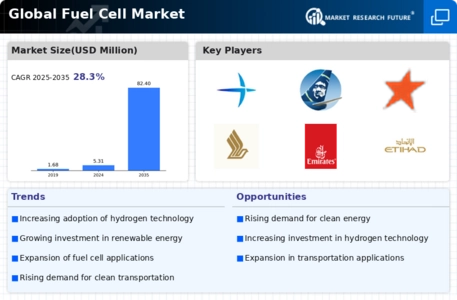Top Industry Leaders in the Fuel Cell Market
*Disclaimer: List of key companies in no particular order
Competitive Landscape of the Fuel Cell Market: A Dynamic Powerhouse
The fuel cell market, projected to reach USD 8.7 billion by 2028, presents a vibrant environment with various strategies, trends, and players vying for dominance. This analysis dissects the competitive landscape, highlighting key aspects:
Fuel Cell Key Players and Strategies:
- Established Giants: Companies like Bloom Energy, Doosan Fuel Cell, Aisin Corporation, Plug Power, and KYOCERA Corporation hold significant market share. Their strategies revolve around:
- Partnerships & Collaborations: Forging alliances with technology providers, automakers, and infrastructure developers to expand reach and expertise.
- Mergers & Acquisitions: Consolidating market share and acquiring specialized know-how through strategic acquisitions.
- Geographical Expansion: Entering new markets with high growth potential, especially in Asia and Europe.
- Product Diversification: Developing fuel cell solutions for diverse applications beyond traditional segments like transportation and stationary power.
- Emerging Challengers: Startups and smaller players like Cummins, FuelCell Energy, and Solid Power are gaining traction:
- Technological Innovation: Focusing on next-generation fuel cell technologies like Solid Oxide Fuel Cells (SOFCs) for higher efficiency and reduced costs.
- Niche Specialization: Addressing specific application needs in sectors like portable power, maritime, and aerospace.
- Cost Reduction: Implementing manufacturing advancements and material substitutions to make fuel cells more cost-competitive.
Factors for Market Share Analysis:
- Technology Leadership: Holding intellectual property and demonstrating superior performance metrics like efficiency, durability, and power density.
- Production Capacity and Cost Competitiveness: Ability to scale production efficiently and offer competitive pricing through economies of scale.
- Customer Service and After-Sales Support: Providing comprehensive solutions, including installation, maintenance, and fuel infrastructure support.
- Brand Recognition and Reputation: Building trust and establishing a strong brand image within the industry.
- Geographical Presence and Market Access: Operating in key markets with supportive policies and high demand for fuel cell solutions.
New and Emerging Trends:
- Hydrogen Infrastructure Development: Investments in hydrogen production, transportation, and refueling stations are crucial for widespread fuel cell adoption.
- Policy and Regulatory Support: Government incentives, emission regulations, and carbon pricing mechanisms significantly impact market growth.
- Cost Reduction Efforts: Advances in materials, manufacturing processes, and fuel sources are lowering the overall cost of fuel cell systems.
- Fuel Cell Vehicle (FCV) Expansion: Automakers are introducing new FCV models, with a focus on longer range, faster refueling, and lower costs.
- Stationary Power Applications: Fuel cells are gaining traction in data centers, microgrids, and backup power systems due to their reliability and clean energy generation.
Overall Competitive Scenario:
Factors like production capacity, cost competitiveness, and customer service play a crucial role in market share analysis. New trends like hydrogen infrastructure development, policy support, and cost reduction efforts are shaping the future of the industry. With FCV expansion and increased adoption in stationary power applications, the competitive landscape promises to be even more exciting in the coming years.
Industry Developments and Latest Updates
Airbus:The company is developing the ZEROe project, exploring various hydrogen-powered aircraft configurations, including some featuring fuel cells. The first test flight is expected in 2025. (Source: Airbus website)
EasyJet:In 2020, the airline partnered with Wright Electric for research on electric and hydrogen-powered aircraft, but there haven't been any substantial updates since then. (Source: EasyJet website)









